工程流体力学(英文版)第二章.pdf
工程流体力学 第二章
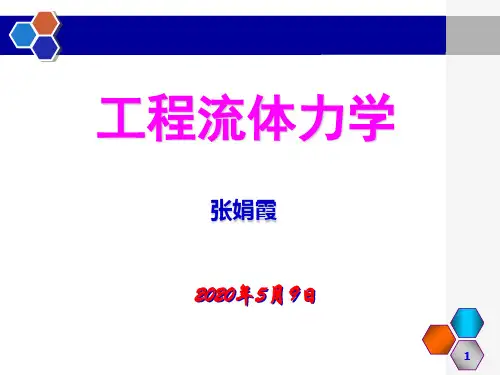
只反映 在空间点(x,y,z) 处的时间变化特性 (即不同时刻经过该空间点的流体质点具有不 同的 ),不代表同一质点物理量的变化,所 以不是质点导数。
30
2.2.4 质点导数
( x , y , z , t ) t
反映了物理量在空间点(x,y,z)处的时间变化 特性,故可用来判定流场是否是稳态流场, 若是稳态的,则
或以速度分量表示为: dx vx v x ( a, b, c, t ) dt dy vy v y ( a, b, c, t ) dt dz vz v z ( a, b, c, t ) dt
16
2.2.1 拉格朗日法
一般地,流体任意运动参数或物理量(无 论矢量或标量)都同样可表示成拉格朗日 变量函数:
(a, b, c, t )
( x, y , z , t )
23
2.2.3欧拉表达式变换为拉格朗日
已知欧拉法描述的速度场:u=x,v=-y和 初始条件: x=a,y=b. 求速度和加速度的拉格朗日描述。
24
2.2.3欧拉表达式变换为拉格朗日表达式
已知流场速度和压力分布为:
xy v vxi v y j vz k i yj ztk t 1 e At 2 p 2 x y2 z2
的有限空间或微元空间作为研究对象,通过
研究该空间的流体运动及其受力,建立相应动
力学关系。
3
2-1 流场及流动分类
流场的概念 流场所占据的空间。为描述流体在流场内各 点的运动状态,将流体的运动参数表示为流 场空间坐标(x,y,z)和时间t的函数。
v v( x, y, z, t ) vx i v y j vz k
工程流体力学第二章2020(版)
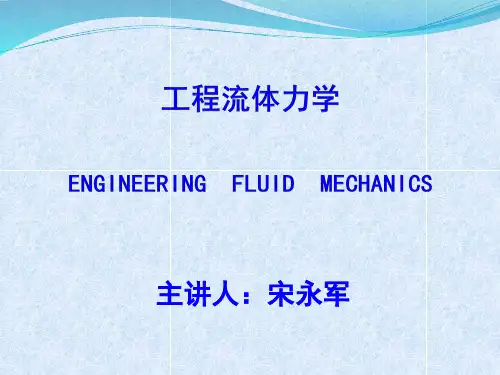
解:假设两盘之间流体的速度为直线 分布,上盘半径r处的切向应力为:
r
所需力矩为: M
d
0
2 2rdr r
2 d 2 r 3dr
0
d 4 32
d
dr r
牛顿流体:切向应力和流体的速度梯度成正比的流体, 即满足牛顿粘性应力公式的流体。 非牛顿流体:不满足牛顿粘性应力公式的流体。
dvx dy
n
k
上式中, 为流体的表观粘度,k为常数,n为指数。
dx dy
A:牛顿流体,如水和空气
B:理想塑性体,存在屈服应力τ。如牙膏
C:拟塑性体,如粘土浆和纸浆
D:胀流型流体,如面糊
o
D A CB
0
τ
理想流体:假设没有粘性的流体,即 =0。
理想流体是假想的流体模型,客 观上并不存在。实际流体都是有 粘性的。
12
应用1:如下图所示,转轴直径d=0.36m,轴承长度l=1m,轴与轴承 之间的间隙=0.2mm,其中充满动力粘度=0.72Pa·s的油,如果轴 的转速n=200 r/min,求克服油的粘性阻力所消耗的功率。
分析:油层与轴承接触面上的速度为
d
零,与接触面上的速度等于轴面上的
线速度:
r r n 0.18 200 3.77 m/s
出现两种情形: ①润湿:内聚力>附着力, 液体依附于固体壁面。如:水在玻璃管内。
②不润湿:内聚力<附着力, 主讲人:宋永军
第二章 流体及其物理性质
2.1 流体的定义和特征
定义:能够流动的物质为流体; 定义(力学):在任何微小剪切力的作用下都能发生连续 变形的物质称为流体。 特征:流动性、压缩、膨胀性、粘性
物态
固体 液体 气体
工程流体力学第二章 流体及其物理性质
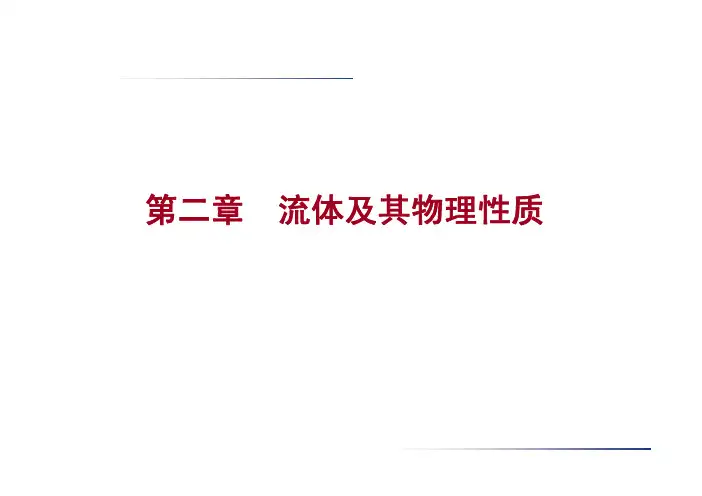
第五节 流体的粘性
牛顿内摩擦定律:
牛顿在《自然哲学的数学原理》中假设:“流体两部分由于缺乏润滑而引起 的阻力与速度梯度成正比”。
F ' A
U H
dv x dy
xt / y d x d lim lim t t 0 0 dt t t dy
固体:既能承受压力,也能承受拉力与抵抗拉伸变形。 流体:只能承受压力,一般不能承受拉力与抵抗拉伸变形。
第一节
液体和气体的区别:
流体的定义和特征
气体易于压缩;而液体难于压缩; 液体有一定的体积,存在一个自由液面;气体能充满任意形 状的容器,无一定的体积,不存在自由液面。
液体和气体的共同点:
两者均具有易流动性,即在任何微小切应力作用下都会发生 变形或流动,故二者统称为流体。
第二节 流体的连续介质模型
连续介质(continuous medium) 质点连续地充满所占空间的流体或固体。 连续介质模型(continuous medium model) 把流体视为由流体质点没有间隙地充满它所占据的整 个空间的一种连续介质,表征流体状态的宏观物理量(速 度、温度、压强、密度等)都是空间坐标和时间的连续函 数的一种假设模型:
第三节 流体的密度 相对密度 比容
密度:单位体积内流体所具有的质量。
密度表征流体在空间的密集程度。
密度:
m lim V 0 V
kg m 3
对于均质流体:
m = V
1
比体积(比容):密度的倒数。 v 相对密度:
d= f w
式中, f -流体的密度(kg/m3)
第四节 流体的压缩性和膨胀性
流体的膨胀性 当压强一定时,流体温度变化体积改变的性质称为流 体的膨胀性,膨胀性的大小用温度体胀系数来表示。 体胀系数:
工程流体力学英文原版
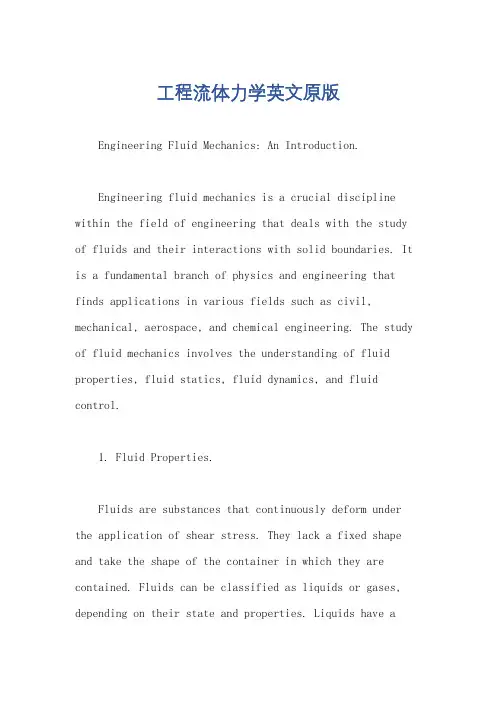
工程流体力学英文原版Engineering Fluid Mechanics: An Introduction.Engineering fluid mechanics is a crucial discipline within the field of engineering that deals with the study of fluids and their interactions with solid boundaries. It is a fundamental branch of physics and engineering that finds applications in various fields such as civil, mechanical, aerospace, and chemical engineering. The study of fluid mechanics involves the understanding of fluid properties, fluid statics, fluid dynamics, and fluid control.1. Fluid Properties.Fluids are substances that continuously deform under the application of shear stress. They lack a fixed shape and take the shape of the container in which they are contained. Fluids can be classified as liquids or gases, depending on their state and properties. Liquids have adefinite volume but no fixed shape, while gases expand tofill the available space.Some important fluid properties include density, viscosity, compressibility, and surface tension. Density is the mass per unit volume of a fluid. Viscosity representsthe internal friction of a fluid and affects its flow behavior. Compressibility describes how a fluid responds to changes in pressure, while surface tension arises from the intermolecular forces at the fluid's surface.2. Fluid Statics.Fluid statics deals with the behavior of fluids at rest, or in equilibrium. It involves the study of pressure distribution in fluids, buoyancy, and hydrostatics.Pressure is a force per unit area acting perpendicular tothe surface, and it is a fundamental quantity in fluid mechanics. Buoyancy is the upward force exerted by a fluid on an immersed object, and it is responsible for thefloating of objects on water. Hydrostatics deals with the equilibrium of fluids under the influence of gravity andother external forces.3. Fluid Dynamics.Fluid dynamics is concerned with the motion of fluids and the forces acting on them. It involves the study of fluid flow, fluid mechanics equations, and fluid control. Fluid flow can be laminar or turbulent, depending on the velocity and other fluid properties. Laminar flow is smooth and orderly, while turbulent flow is chaotic and irregular.The fundamental equations of fluid dynamics include the conservation of mass, momentum, and energy. The conservation of mass states that the rate of change of mass within a control volume is equal to the net mass flow rate into the volume. The conservation of momentum relates the forces acting on a fluid element to its acceleration, while the conservation of energy accounts for the conversion of energy forms within a fluid system.4. Fluid Control.Fluid control involves the manipulation and manipulation of fluid flow using pumps, valves, and other devices. Pumps are used to increase the pressure or flow rate of a fluid, while valves are used to control the direction or amount of fluid flow. Other devices such as nozzles, diffusers, and turbines are also employed to modify fluid flow characteristics.In conclusion, engineering fluid mechanics is a crucial discipline that deals with the study of fluids and their interactions with solid boundaries. It involves the understanding of fluid properties, fluid statics, fluid dynamics, and fluid control. This knowledge is essentialfor engineers to design, analyze, and optimize fluid systems in various engineering applications.。
工程流体力学第二章

pxdydz pnds • sin dz 0
p y dxdz
pnds
•
cos
dz
1 2
dxdydz
g
0
所以:
px pn 0
故
py
pn
1 2
dyg
0
y b
pxdy
o
px pn py pn
pnds
G x a
p y dx
得证
微元体分析法的步骤: 1 取合适的微元体 2 受力分析 3 建立方程
F pcg A ghc A
y D
y C
J cx yA
c
常见几何形状的惯性矩(表2-2)
矩形 圆型
c
l
J cx
1 12
bl 3
b
cR
J cx
1 R4
4
¼圆
xc c yc
xc
yc
4R
3
J cx
(1 4
16
9 2
R4
) 4
例2-5 设矩形闸门的宽为6米,长10米,铰链到低水面的 距离为4米。按图示方式打开该闸门,求所需要的力 R。
z
p0
o
B
z
p0
o
B
R
(a)
pg
2
2r2
R
(b)
pg
2
2(r2
R2)
例2-4 设内装水银的U型管绕过D点的铅垂线等角速度旋 转,求旋转角速度和D点的压强。设水银密度为
13600kg/m3 且不计液面变化带来的影响。
ω
关键:
10cm 5cm
1 写出所有的体积力
20c m
z
12cm 2 根据压力差公式写出压强
流体力学 英文课件第二章
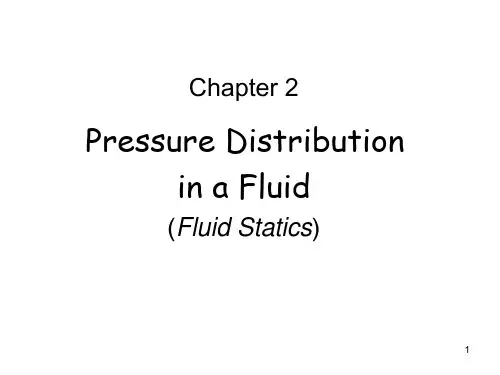
9
Application ?
p0
pA = p0 + ρgh pG = ρgh
绝压 表压
h p
Absolute pressure (绝对压力) Gauge pressure(表压力)
Pressure source Connected water tube
Relative pressure(相对压力) Vacuum degree(真空度)
p = p0
ax z =− x g
Equipressure surface(等压面)
ax z = − x +C g
12
Example:
A cup of coffee is 7cm deep at rest. 1. Will it spill out while ax=7m/s2? 3 2. Gage pressure of point A? (ρ =1010 kg m )
dp = ρ( Xdx +Ydy + Zdz)
Pressure increase in the direction of body force.
Equipressure surface(等压面)
Surfaces in fluid with same pressure, vertical to body force everywhere, in gravity field it is a horizontal plane.
∂p dx ∂p dx p− dydz − p + dydz + ρXdxdydz = 0 ∂x 2 ∂x 2
Force on left surface Force on right surface Body force in x direction
工程流体力学 - 第2章 - M
z
dz
dp f x dx f y dy f z dz
这就是流体平衡压强分布规律的基本微分关系式。
将(1)中三个方程交叉求导得:(不可压缩均质 流体 = c ) f x f y y x f y f z z y f z f x x z 上式表明存在势函数 (x、y、z)满足:
这种测压管的优点: 结构简单,测量准确;
缺点:
被测压强不能太大
2、U型测压计
U形管测压计的工作液 体的密度较大,其测量 范围比测压管大,它测 量容器中的绝对压强可 以高于大气压强,也可 以低于大气压强,被测 流体可以是气体,也可 在是液体。
(a)测计示压强
p1 p 2
p1 p 1 gh1 p 2 p a 2 gh2
等压面方程
ax gz C
等压面已不是水平面,而是一簇平行的斜面。其与x方 向的倾斜角为
a arctan g
自由表面上,取坐标原点x=0,z=0时,积分常数C =0,故自由表面方程为
ax+gzs=0
或
zs
a zs a x x g g
式中zs—自由表面上点的z坐标,称为超高。 相对平衡液体的压强分布规律:
同理可得 py=pn,pz=pn 。这里的 就是任意方向微元 平面上的应力 ,它和该点坐标平面方向的应力 相等。 特征②表明静压力是各向同性的,仅是坐标点 的函数。
p p(x, y,z)
§2.3 流体静力学的基本方程
静止流体中任取一微元六 面体,其边长分别为 dx , dy , dz ,坐标的选取如 下图。 分析 x 方向的受力平 衡情况:作用于微元体 上的质量力在 x 方向的投 影为 f x d x d y d z ,设 六面体形心处的静压强
工程流体力学 第二章 流体静力学201012
z ω
1.等压面方程 1.等压面方程
dp = ω 2 xdx + ω 2 ydy − gdz = 0
⇓ 积分
ω 2 x2
2 +
p0
o
m
h z
zs y
ω 2 y2
2
− gz = C
ω 2r 2
2
− gz = C
等压面是一簇绕z轴的旋转抛物面。 等压面是一簇绕z轴的旋转抛物面。 自由液面: 自由液面: x=0 z=0 C=0
z g p0
2
⇒
dp = ρ(Xdx +Ydy + Zdz)
dp = −ρgdz
p2
p1
1
⇒
dp dz + =0 ρg
z1
z2
积分得: 积分得:
p z+ =C ρg
o
p p z1 + 1 = z2 + 2 ρg ρg
基准面
x
2.物理意义 2.物理意义
z+ p =C ρg
总 势 能
3.几何意义 3.几何意义
o y
αr
y x ω2y ω2r
⇓
zs =
ω 2r 2
2g
x
ω2x
二、等角速旋转容器中液体的相对平衡
2. 静压强分布规律
dp = ρ (ω 2 xdx + ω 2 ydy − gdz )
z ω
⇓ 积分
p = ρ(
ω 2x2
2
+
ω 2 y2
2
− gz ) + C
p = ρg (
ω 2r 2
流体力学英文版第二章静力学——Hydrostatic
δFs = −
∂pˆi + ∂p ˆj + ∂p kˆ ∂x ∂y ∂z
δxδyδz = −∇pδxδyδz
6 / 32
Basic equation for pressure field
Notes
Besides the surface forces, the body force due to the weight of the
δxδz
It is simplified to
∂p
δFy
=
− δxδyδz ∂y
Similarly, for the x and z directions, the resultant surface forces are
∂p
∂p
δFx
=
− δxδyδz, ∂x
δFz
=
− ∂z
δxδyδz
In the vector form, it can be expressed as
element is
δFv = −ρgδxδyδzkˆ
The whole resultant force acting on the rectangular element of fluid can be expressed as
δF = δFs + δFv = −∇pδxδyδz − ρgδxδyδzkˆ = δma
Figure 4: Face and body forces acting on a rectangular element
5 / 32
Basic equation for pressure field
Notes
In the y direction
∂p δy
流体力学(英文课件)chap2
U
U
Viscosity is a measure of a fluid's resistance to flow.
12
Fluid Mechanics 2010 CN Chapter 1
1. Physical characteristics
2. Viscosity (9)
5
1. Physical characteristics
2. Viscosity (2)
What is viscosity ?
Absolute viscosity is a measure of the resistance of a fluid to flow.
Higher viscosity: slower flow
Fluid Mechanics 2010 CN Chapter 1
10
1. Physical characteristics
2. Viscosity (7)
F
y
U
u ky
o
x
Model of a laminar shear flow: Under the influence of a F tangential force F a pile of layers is sheared in x-direction. The top layer moves constantly at the velocity vx.
Basics of
Fluid Mechanics
Chapter 1: § 2 Viscosity
Marc Henn
Contents
1. Physical characteristics of fluids 1.2 Viscosity
- 1、下载文档前请自行甄别文档内容的完整性,平台不提供额外的编辑、内容补充、找答案等附加服务。
- 2、"仅部分预览"的文档,不可在线预览部分如存在完整性等问题,可反馈申请退款(可完整预览的文档不适用该条件!)。
- 3、如文档侵犯您的权益,请联系客服反馈,我们会尽快为您处理(人工客服工作时间:9:00-18:30)。
)dxdz
+
f y ρdxdydz
=
0
fy
−
ρ1
∂p ∂y
=
0
Differential Equations of a Fluid in Equilibrium˄Euler Equilibrium Equations˅˖
fx
−
ρ1
∂p ∂x
=
0
fy
−
ρ1
∂p ∂y
=
0
fz
−
ρ1
∂p ∂z
=
0
˄or˅
f − ρ1 gradp = 0
2.2.2 Pressure Difference Equation ( General Differential Equations of a Fluid in
Equilibrium)
Ĩp = p(x,y,z)
fx
−
ρ1
∂p ∂x
=
0
fy
−
ρ1
∂p ∂y
=
0
fz
−
ρ1
∂p ∂z
=
0
ħ
the
total
2.2 Differential Equation of Fluid Equilibrium 2.3 Pressure Distribution in the Static Fluid 2.4 Pressure Mearurements 2.5 Fluid in Relative Equilibrium Fluid. 2.6 Fluid Static Force on Plane and Curved Area
p = p (x, y, z)
2.2 Differential Equation of Fluid Equilibrium
1 Differential Equations of a Fluid in Equilibrium ------Euler Equilibrium Equations
2 Pressure Difference Equation 3 Force Potential Function 2 Surface of Equal Pressure
If the density is a constant:
d ( p ρ ) = fxdx + f y dy + fzdz
Define a force potential function:
p
ρ
=
−π
d
p
ρ
=
d
(−π
)
=
−
∂π
∂x
dx
−
∂π
∂y
dy
−
∂π
∂y
dz
fx
=
−
∂π
∂x
fy
=
−
∂π
∂y
fz
=
−
ρ1
∂p ∂y
=
0
fz
−
ρ1
∂p ∂z
=
0
˄or˅
f − ρ1 gradp = 0
Physical Meaning:
For the fluid in equilibrium, surface force components per mass fluid are equal to mass
force components per mass fluid. Pressure variation rate in axes directions
px = py = pz = pn
z A
px
dz
pn
py
0 dy dx
pz B x
C y
(1) Select a triangular prism element OABC, dx, dy, dz
px, py, pz, pn are pressure intensity acted on the respective surface. n is normal direction of inclined surface ABC.
p = lim Fn A→ 0 A
Unit: Pa or N/m2
2.2.1 Characteristic
1ǃdirection
Negative √
Normal
Force
Positive--Pulling
Shearing
There is only compressive stress (or pressure ) in a fluid at rest , and the direction of pressure is the same as the direction of inward normal line of acting point . Fluid at rest cannot bear pulling force because of the trends to flow.
2.2 Differential Equation of Fluid Equilibrium
2.2.1 Differential Equations of a Fluid in Equilibrium ------Euler Equilibrium Equations
Consider the six surfaces of infinitesimal element in equilibrium fluid. Its sides are dx,dy,dz. Assume the pressure at the center of the element is p(x,y,z)=p.
Mass forces˖
f
x
⋅
ρ
1 6
dxdydz
,
z A
px
dz
pn
py
0 dy dx
pz B x
C y
f
ห้องสมุดไป่ตู้
y
⋅
ρ
1 6
dxdydz
,
fz
⋅
ρ
1 6
dxdydz
(3) Equation of fluid in equilibrium
Consider force components in x direction:
F =0
px
⋅
1 2
dydz
−
pn
⋅ dAcos(n, x) +
fx
⋅ρ
1 dxdydz 6
=
0
px
⋅ 1 dydz 2
−
pn
⋅ dAcos(n, x) +
fx
⋅ρ
1 dxdydz 6
=
0
And:
dAcos(n, x) = 1 dydz 2
z A
dz py
px pn
So:
px
⋅ 1 dydz 2
The n results show that the pressures are independent of direction n because n is arbitrary.
Hence the pressure at a point on a static fluid is the
same in all directions.
condition:
Equilibrium and relative equilibrium Compressible and incompressible flow
2.2 Differential Equations of a Fluid in Equilibrium
fx
−
ρ1
∂p ∂x
=
0
fy
dp = 0
fxdx + f ydy + fzdz = 0
Important character of equipressure surface:
f = fxi + fy j + fxk dr = dxi + dyj + dzk
Kinescope Cartoon
f ⋅ dr = 0
mass force of any point on the equipressure surface in equilibrium fluid is perpendicular to the equipressure surface.
+
f z dz
=
ρ1
∂p ( ∂x
dx +
∂p ∂y
dy
+
∂p ∂z
dz)
dp = ρ( fxdx + f ydy + fzdz)
2.2 Differential Equations of a Fluid in Equilibrium
2.2.3 Force Potential Function dp = ρ( fxdx + f y dy + fzdz)
Chapter Two Fluid Statics(⌕ԧ䴭ᄺ˅
What is Fluid Statics
General Rules of fluid at rest, and their engineering application.
fluid at rest
fluid in equilibrium
differential
of
pressure
is:
dp
=
∂p ∂x
dx
+
∂p ∂y
dy
+
∂p ∂z
dz
Multiply every equation in equation group (1) with dx,dy,dz
